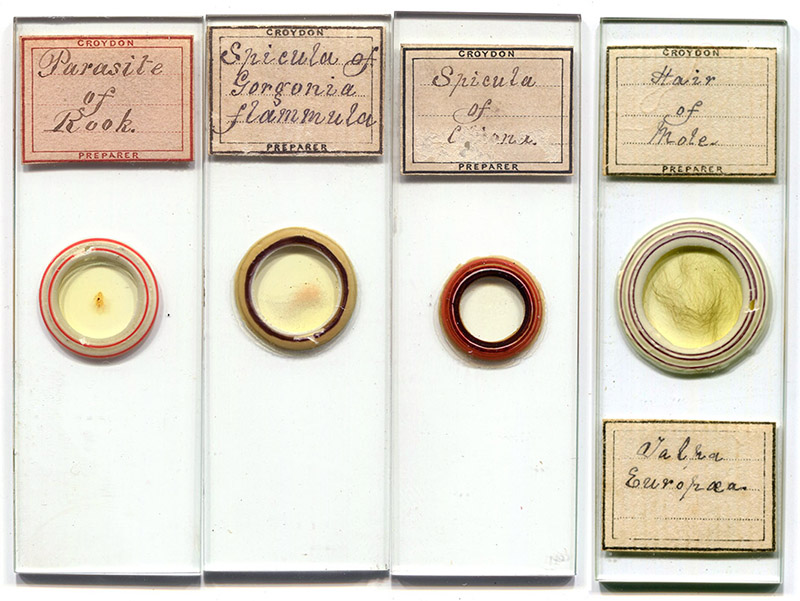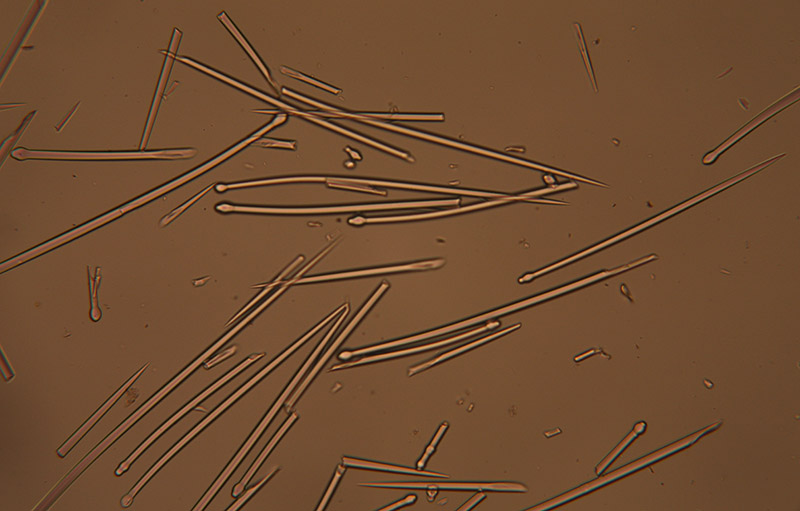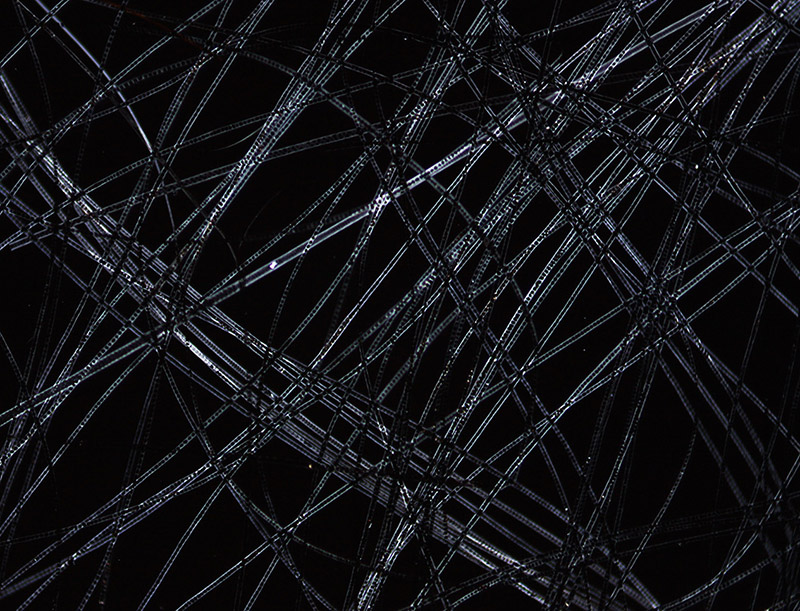
Figure 1. Examples of microscope slides that were made by Charles Croydon. Croydon mounted a wide range of objects, and was an active microscopist from ca. 1870 until his death, in 1891. He advertised to exchange slides of mole hairs in 1870.
Charles Croydon, 1849 - 1891
by Brian Stevenson
last updated August, 2016
Microscope slides labeled “Croydon Preparer” slides occasionally appear at auction (Figure 1). Searches of historical records revealed only one likely preparer, Charles Croydon, who joined the Royal Microscopical Society in 1871, and was also active with a local scientific organization. Croydon lived in the area of Devonport, Devon, England, and worked as a goldsmith, jeweler, and watch-maker.
Croydon’s slides are generally well-made, and of interest both with and without the microscope. His labels resemble a type used by professional slide-maker John Norman, who he may have been emulating. There are no indications to suspect that Croydon was a professional, however.

Figure 1.
Examples of microscope slides that were made by Charles Croydon. Croydon mounted a wide range of objects, and was an active microscopist from ca. 1870 until his death, in 1891. He advertised to exchange slides of mole hairs in 1870.
Two men by the name of Charles Croydon lived in Devonport, father and son. Based on the year that the microscopist joined the Royal Microscopical Society (1871, when the father was about 51 and the son was 22 years old) and the last record of Croydon in the RMS being the year of the son’s death (1891), it is most likely that the younger Croydon was our microscope slide-maker.
Charles was born in Devonport on April 16, 1849, the first child of Charles and Ann Wollacott Croydon. The father was evidently a successful jeweler and watch-maker: censuses record him as employing multiple assistants, and the family consistently had a domestic servant. Mother Ann died during the 1870s, while the father died in 1906. The younger Charles did not marry, living with his father and younger sisters throughout his life. The shop of Charles Croydon & Son was located at 20 Fore Street, Devonport. From 1871 onward, the family lived across the River Tamar at Pato Point, Torpoint, Cornwall.
Charles posted an exchange offer in the February, 1870, issue of Hardwicke’s Science-Gossip, “Sections of Elephant's Hair (transverse), mounted, and Australian Cotton, mounted for polariscope, for mounted and named Diatoms or Foraminifera. - C. Croydon, 20, Fore Street, Devonport”. This is the earliest identified evidence of Croydon’s interest in microscopy. His ability to prepare transverse (cross) sections of hairs and thin sections of animal hooves (see below) indicate that he possessed a microtome or other sectioning tool, and suggests that he had been developing his mounting skills for some time prior to 1871.
Another exchange offer, for some very different types of specimens, was published in the next month’s issue, “Sections of Hoof of Pig and Ox, and Hair of Polar Bear, Field-mouse, Mole, and Chinchilla (all mounted), in exchange for good mounted objects; Insects preferred. - C. Croydon, 20, Fore Street, Devonport”.
Also in the March, 1870, issue of Hardwicke’s Science-Gossip, Croydon published this query, “The Frog. - Having observed many notices of the spawning of the frog as late as March in some districts, I should like to know whether this is the invariable rule in those localities, and if so, what is the average temperature during the months of January, February, and March; as here, in the south of Devon and on the borders of Cornwall, I never fail to obtain spawn during the month of January, and this year I first saw it on the 14th. It would be a matter of some interest to zoologists to know whether the great difference in time is due to the temperature, or, if not, to what other local causes. - C. Croydon, Devonport”. It is notable that Croydon did not mention either a species or common name for “the frog”, suggesting inexperience with zoology.
Croydon was a member of the Devonshire Association for the Advancement of Science, Literature, and Art, exhibiting “most interesting specimens of animal and vegetable physiology” at the association’s July, 1871, annual meeting. He was elected to membership in the Royal Microscopical Society on December 6, 1871. The last record of his membership in the RMS was the list of 1891 members (published in 1892).
Two further exchange offers from Croydon have been, both from 1884 issues of Hardwicke’s Science-Gossip, “Foraminifera from the coast of Galway, Ireland, and gold sand with gem pebbles from the Ovens Diggings, Australia, mounted; for other good mounts, insect preparations preferred; objects of animal physiology or diatoms not acceptable. - C. Croydon, Pato Point, Torpoint, Cornwall”, and “Microscopic slides in great variety, well mounted, in exchange for other well-mounted slides. Lists exchanged. - C. Croydon, Pato Point, Torpoint, Cornwall”.
Charles Croydon died during the spring of 1891, when only 42 years old.

Figure 2.
Spicules of gorgonia, mounted by Charles Croydon.

Figure 3.
Hair of mole Talpa europaea, mounted circa 1870 by Charles Croydon. Viewed between crossed polarizing filters (polariscope).
Resources
Charter and Bylaws of the Royal Microscopical Society (1892) “Croydon, Charles, Pato Point, Wilcove, Torpoint, Cornwall”, List of fellows corrected to May 18th, page 30 (note: Croydon had not paid his dues for 1892)
Croydon, Charles (1870) The frog, Hardwicke’s Science-Gossip, Vol. 6, page 71
England census, birth, marriage, and death records, accessed through ancestry.co.uk
Hardwicke’s Science-Gossip (1870) Exchange offers from Charles Croydon, Vol. 6, pages 48 and 72
Hardwicke’s Science-Gossip (1884) Exchange offers from Charles Croydon, Vol. 20, pages 120 and 144
Kelly’s Directory of the Watch and Clock Trades (1880) “Croydon Charles & Son, 20 Fore St. Devonport, Devon”, page 237
Monthly Microscopical Journal (1871) Election of Charles Croydon to membership in the Royal Microscopical Society, Vol. 7, page 38
Report and Transactions of the Devonshire Association for the Advancement of Science, Literature, and Art (1871) “The Ninth Annual Meeting, held at Devonport, commenced on Tuesday, July 26th … On Wednesday, the 27th, … the Annual Dinner of the Members took place at the Royal Hotel. The President occupied the chair, and about sixty members and ladies sat down to a well-served repast. After dinner the usual complimentary toasts were drunk and speeches made … tables again were occupied by microscopes and other objects of scientific interest. The microscopic exhibition was a great success, the gentlemen who undertook the supervision being Dr. Dansey, Mr. Codd (who also showed his fine spectroscope, one of Browning’s best instruments), Mr. Heath, Mr. Croydon, and Rev. T.W. Freckleton; the objects exhibited and explained being most interesting specimens of animal and vegetable physiology, marine Zoophites (living), and a splendid collection of injected preparations illustrative of human and comparative anatomy, exhibited by Dr. Dansey”, Vol. 4, pages 370-317